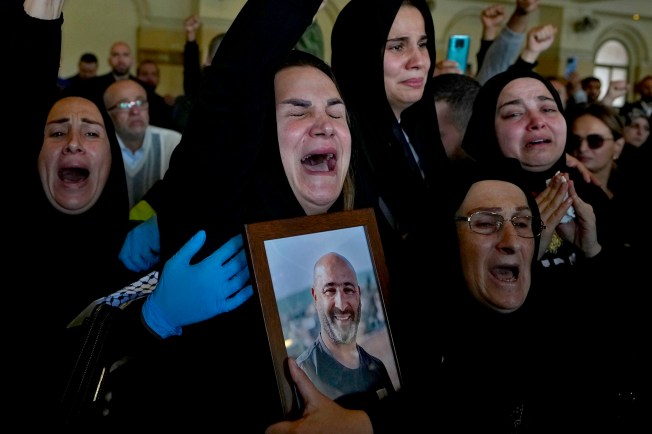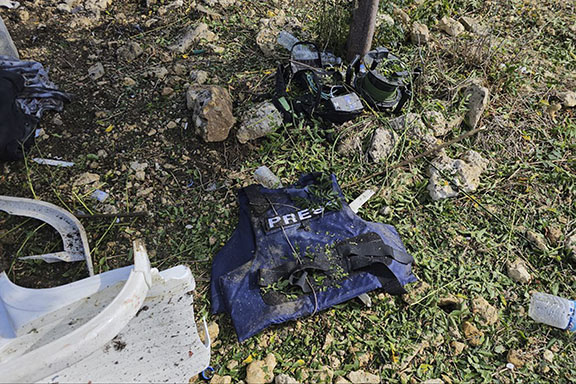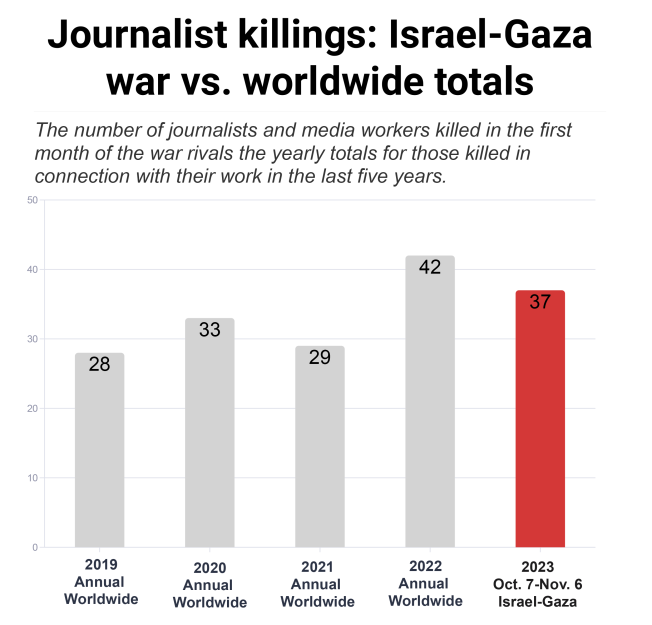Killed, injured, or missing
The Israel-Gaza war has taken a severe toll on journalists since Hamas launched its unprecedented attack against Israel on October 7 and Israel declared war on the militant Palestinian group, launching strikes on the blockaded Gaza Strip.
CPJ is investigating all reports of journalists and media workers killed, injured, or missing in the war, which has led to the deadliest month for journalists since CPJ began gathering data in 1992.
See the list here
Israel-Gaza war news
- Journalist casualties in the Israel-Gaza war
- Attacks, arrests, threats, censorship: The high risks of reporting the Israel-Gaza war
- Photos: Israel-Gaza war takes unprecedented toll on journalists
- Al-Mayadeen TV reporter and videographer killed by Israeli strike in south Lebanon
- CPJ pays tribute to slain Palestinian press freedom defender Bilal Jadallah
- CPJ expresses grave concern over 4th communications blackout in Gaza
- FAQ: How CPJ documents journalist deaths in the war
- CPJ condemns strike on AFP bureau in Gaza
- Egypt bans Mada Masr website for 6 months over report on Israel-Gaza war
- CPJ statement on news blackout in Gaza


PHOTOS: War takes unprecedented toll on journalists
Here are images of journalists working under extreme, heartbreaking, and sometimes fatal circumstances to cover the fighting.
__________________________

The high risks of reporting the war
Since the Israel-Gaza war began, journalists and media across the region have faced a hostile environment that has made reporting on the war exceptionally challenging.
CPJ’s research to date has found many incidents of journalists being targeted while carrying out their work in Israel and the two Palestinian territories, Gaza and the West Bank. These include arrests, as well as assaults, threats, cyberattacks and censorship.
Read the story here
CPJ safety advisories
As we continue to monitor the war in Israel/Gaza, journalists who have questions about their safety and security can contact us emergencies@cpj.org.
For more information, read:
- Physical Safety: War Reporting
- Physical and digital safety: Civil Disorder
- Psychological Safety
- Physical and digital safety: Arrest and detention
These are available in multiple languages, including Arabic.
Mental health resources for journalists
Resilience/mental health resources for journalists dealing with violent imagery and trauma.
- Headlines Network: Vicarious trauma: A guide for journalists and newsrooms to recognize vicarious trauma and mitigate against it
- Dart Center: Working with Traumatic Imagery
- Dart Center: Handling Traumatic Imagery: Developing a Standard Operating Procedure
- First Draft: Journalism and vicarious trauma: A guide for journalists, editors, and news organizations
- CPJ: Psychological safety 101
Interactive map
Methodology: Read our FAQs page
Source: Committee to Protect Journalists
Last update: Dec. 5, 2023
Map by Geoff McGhee for CPJ
Deaths in Israel-Gaza Conflict
Killed in Israel-Gaza Conflict
FAQ
How many journalists have died since the Israel-Gaza war began on October 7?
Dozens have died; see an updated list here.
How do these numbers compare to prior conflicts?
There have been more journalists killed in the first month of the Israel-Gaza war than in any other similar period of conflict since CPJ started recording such deaths in 1992.
In the first month of the war, 37 journalists and media workers were killed in connection with their work. In comparison, CPJ documented 68 journalists and media workers killed around the world in the whole of 2022. Forty-two of them were killed in connection with their work; CPJ has not yet been able to confirm whether the other 26 deaths were related to their journalism. (Read more about CPJ’s methodology here and here.)
Why are the numbers in your casualty report different from those in your annual database of journalists killed?
Our priority is to update the casualty listings as soon as a journalist’s death is confirmed by at least two sources. We then try to get more details about the circumstances of their deaths before we enter their names into our database. This means there is sometimes a time lag between the casualty report and the database. The casualty report contains the most up-to-date information.
Why are some causes of killings listed as “Israeli airstrikes” and others listed as “strikes”?
An airstrike is defined as an attack by military airplanes dropping bombs or other ordnance. In wartime, it’s not always immediately clear whether an attack was the result of an airstrike or ground-launched weapons. As the Israeli military controls the airspace over Israeli-Palestinian territory, CPJ lists cause of death as an Israeli airstrike when we have determined the source of the attack based on available information — typically from at least two independent sources. If we do not have this information, we initially describe the cause of death as a strike. If additional details — such as crater analysis showing the origin of the ordnance — become available, we’ll update our database accordingly.
How does CPJ define a journalist?
CPJ defines journalists as people who cover news or comment on public affairs through any medium — including in print, online, via broadcast media, or photographs and video. We take up cases involving staff journalists and freelancers. We do not include journalists if there is evidence that they were acting on behalf of militant groups or serving in a military capacity at the time of their deaths.
CPJ is also documenting the deaths of media support workers in recognition of the vital role they play in news gathering. These include translators, drivers, guards, fixers, and administrative workers.